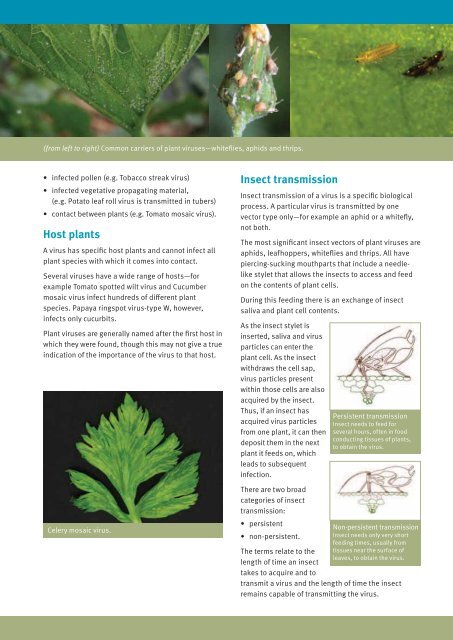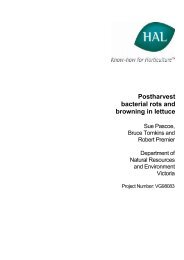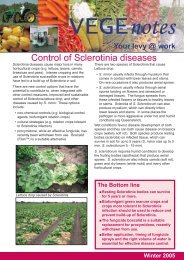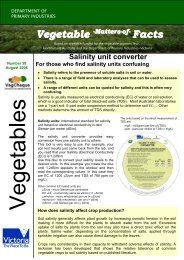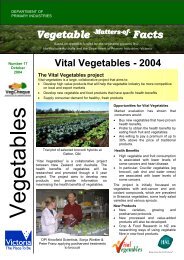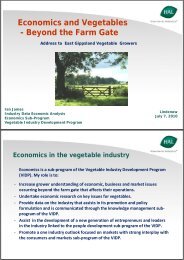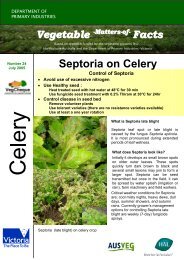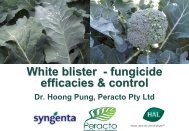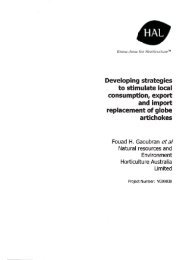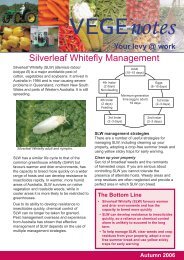Viruses in vegetable crops in Australia
Viruses in vegetable crops in Australia
Viruses in vegetable crops in Australia
You also want an ePaper? Increase the reach of your titles
YUMPU automatically turns print PDFs into web optimized ePapers that Google loves.
(from left to right) Common carriers of plant viruses—whiteflies, aphids and thrips. <strong>in</strong>fected pollen (e.g. Tobacco streak virus) <strong>in</strong>fected vegetative propagat<strong>in</strong>g material,(e.g. Potato leaf roll virus is transmitted <strong>in</strong> tubers) contact between plants (e.g. Tomato mosaic virus).Host plantsA virus has specific host plants and cannot <strong>in</strong>fect allplant species with which it comes <strong>in</strong>to contact.Several viruses have a wide range of hosts—forexample Tomato spotted wilt virus and Cucumbermosaic virus <strong>in</strong>fect hundreds of different plantspecies. Papaya r<strong>in</strong>gspot virus-type W, however,<strong>in</strong>fects only cucurbits.Plant viruses are generally named after the first host <strong>in</strong>which they were found, though this may not give a true<strong>in</strong>dication of the importance of the virus to that host.Celery mosaic virus.Insect transmissionInsect transmission of a virus is a specific biologicalprocess. A particular virus is transmitted by onevector type only—for example an aphid or a whitefly,not both.The most significant <strong>in</strong>sect vectors of plant viruses areaphids, leafhoppers, whiteflies and thrips. All havepierc<strong>in</strong>g-suck<strong>in</strong>g mouthparts that <strong>in</strong>clude a needlelikestylet that allows the <strong>in</strong>sects to access and feedon the contents of plant cells.Dur<strong>in</strong>g this feed<strong>in</strong>g there is an exchange of <strong>in</strong>sectsaliva and plant cell contents.As the <strong>in</strong>sect stylet is<strong>in</strong>serted, saliva and virusparticles can enter theplant cell. As the <strong>in</strong>sectwithdraws the cell sap,virus particles presentwith<strong>in</strong> those cells are alsoacquired by the <strong>in</strong>sect.Thus, if an <strong>in</strong>sect hasacquired virus particlesfrom one plant, it can thendeposit them <strong>in</strong> the nextplant it feeds on, whichleads to subsequent<strong>in</strong>fection.There are two broadcategories of <strong>in</strong>secttransmission: persistent non-persistent.Persistent transmissionInsect needs to feed forseveral hours, often <strong>in</strong> foodconduct<strong>in</strong>g tissues of plants,to obta<strong>in</strong> the virus.Non-persistent transmissionInsect needs only very shortfeed<strong>in</strong>g times, usually fromtissues near the surface ofleaves, to obta<strong>in</strong> the virus.The terms relate to thelength of time an <strong>in</strong>secttakes to acquire and totransmit a virus and the length of time the <strong>in</strong>sectrema<strong>in</strong>s capable of transmitt<strong>in</strong>g the virus.


